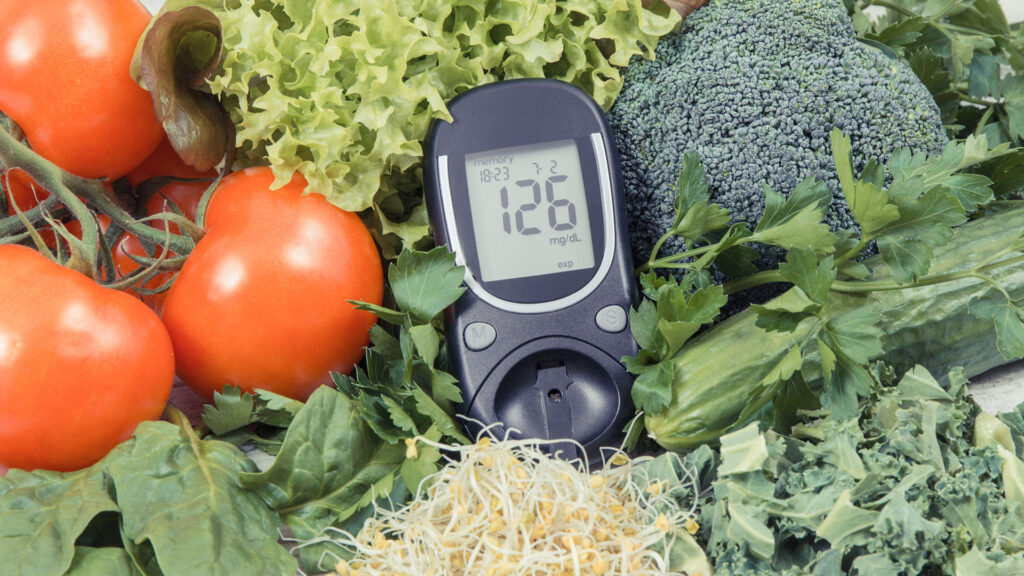Because approximately 90% to 95% of people diagnosed with diabetes are diagnosed with type 2 diabetes, I will focus on this type.
When I speak to someone about their type 2 diabetes diagnosis, they usually start with “I’m going to stop eating sweets and exercise.” That is not a bad idea, but when I ask them about the fats in their diet, the deer in the headlights pops up. No one, not even clients who have been diagnosed for 15 years, have had anyone talk about the fats in their diet. And don’t get me started on how they don’t know what kind of shape their pancreas is in. I’ll cover that in upcoming blogs.
So, let’s dig deep into this type 2 diabetes and nutrition thing.
What is type 2 diabetes?
Type 2 diabetes is an impairment in the regulation and use sugar, specifically glucose, in the body. [i] This chronic condition results in too much glucose circulating in the bloodstream. If you were at your best friend’s wedding the night before your blood test which includes testing your glucose level, your result would be very high. You will recover from the excess glucose swimming around from too much cake and champagne. However, a steady diet of too much glucose swimming around can lead to increased risk of stroke, blindness, amputation, kidney failure and other health issues.
Here’s an interesting fact 1 in 5 people with diabetes don’t even know they have it. Eighty-four percent of prediabetics are completely oblivious to the fact that their health is compromised.
With type 2 diabetes, there are primarily two separate and interrelated problems that can happen at the same time. Your pancreas may not produce enough insulin (a hormone that regulates the movement of glucose into your cells) and the cells not being able to absorb the glucose regardless of insulin being present. [ii]
What are the main symptoms of type 2 diabetes?
These are the most common symptoms: [iii]
- Increased thirst
- Urinating often, especially during the night
- Fatigue
- Losing weight without trying
- Blurry vision
- Sores or cuts that are slow to heal
- Feeling extremely hungry
- Numbness or tingling in your hands or feet
- Having more infections than normal
- Extremely dry skin
- Feeling irritable
- Areas of darkened skin, usually in the armpits and neck [iv]
How does glucose fuel the body ?
Glucose fuels the body just like gas fuels your car. In fact, if you don’t have enough glucose, your body will break down fats, muscle or proteins to create it. Let’s look at the series of events of what happens in a health body after eating a meal:
- You eat breakfast.
- Your enzymes begin to digest the food and release glucose into the blood stream.
- This enzymatic action signals the pancreas to release insulin.
- The insulin enters the blood stream and goes to your cells and works like a key to open the door of the cell.
- The glucose goes into the cell and meets up with the powerhouse of the cell – Mitochondria.
- Mitochondria is the electrical generation station that gives the cell the energy to do its function, whether that be to run your heart, move nerve stimuli down your arm or have your eye blink.
- Life is good.
What changes in how cells work with type 2 diabetes?
You still eat breakfast. You still start to digest the food and release glucose into the blood stream. However, now you can have one of two problems or both.
- Your pancreas is damaged and cannot produce insulin.
- Your glucose cannot enter the cells.
- Your pancreas cannot produce insulin and your glucose cannot enter the cells.
What many people fail to understand is that your pancreas may be pumping out insulin like crazy, [that is known as Insulin Resistance and I will cover that in subsequent posts], but because of the type of food you are eating the glucose will not be able to enter the cell. Why is that? That is what I wanted to know when I joined the GEICO study with the Physicians Committee for Responsible Medicine.
My family is riddled with relatives having type 2 diabetes, including my mother and grandmother. So, I wanted to understand this disease. I heard about a study testing this theory about fat consumption and type 2 diabetes. To be clear, the study was testing more than just fat and type 2 diabetes, but the research participants would include people with diabetes who were not taking insulin but were using medications to control their blood sugar. That was my mother. So, I was very interested in the study being conducted well and having meaningful results.
Everyone agreed to be on a low-fat, vegan diet for four months. By low-fat we meant keeping fats in the diet lower than 20% of total food eaten for the day. By vegan we meant no animal products at all in the foods consumed for the day. Since all vegan foods have fiber, if they ate sufficient calories, they would be eating foods that would keep their bellies satisfied.
To be honest, most people did not adhere to this diet 100%. However, as a research team member and dietitian, my job was not to judge, but to help. I taught participants how to cook without oils, to drop the fats in the food without losing flavor, and how to dine out without animal products. I counseled many participants on how to work around family gatherings and holidays, how to have dessert that met the research parameters [which was one of the most important meals of the day], how to shop and how to read nutrition labels. We followed my Magic 3’s and Max 6 rule for food labels:
- Fats should be no more than 3 grams per serving
- Fiber should be no less than 3 grams per serving
- Sugars should be no more than 6 grams per serving
This rule will zero in on the products that are going to support your health journey and delete the ones that won’t.
Why a low-fat diet with diabetes?
The ratio of calories per gram is why we stressed low-fat. Let me break it down:
- 1 gram of carbohydrate equals 4 calories
- 1 gram of protein equals 4 calories
- 1 gram of alcohol equals 7 calories
- 1 gram of fat [ANY type] equals 9 calories
So, dropping fat would eliminate the highest number of calories per gram of food.
What were the results of the low-fat, high fiber diet and type 2 diabetes?
People dropped weight because their fat intake was low. People weren’t hungry because they were eating foods high in fiber. High fiber foods are very filling and usually low in fat. The people with diabetes did not go into a diabetic coma even though they were eating a LOT more glucose. I had one participant who had been diagnosed as a type 2 diabetic for 11 years and was on 13 medications. In four months, she eliminated all of her medications. Other participants had to have the medical director call their physician and request the participant lower their medication dosage because their blood glucose levels were too low. I have seen this again and again with the research I have worked with and with my own clients.
Why didn’t more glucose in their foods cause more problems with blood sugars?
Two reasons – high fiber and low fat.
Fiber facts.
Fiber is only found in plant foods. It is what supports the plant stems and roots. [v] It also slows the release of glucose. Fiber is like a jacket on the glucose. To release the glucose from the food, you need to unbutton the fiber jacket. This is why there may be as much glucose in a turnip as a chocolate chip, but you don’t have the same sugar spike. The fiber in the turnip is much higher than the chip and takes longer to release into bloodstream. With the slower release your body can absorb the glucose load more efficiently. I will discuss more tips to slow glucose spikes when I write Why does walking after eating lower glucose spikes?
Why did the low-fat lower glucose in the bloodstream?
Let’s go back to the cell. There is all this glucose from your breakfast flowing in the bloodstream along with the saturated fat from the bacon cheese muffin you had. That saturated fat is sticky. Any excess fat sticks to the exterior of the cell and gums up the lock that insulin is supposed to open. There is no way enough glucose can enter the cell to fuel the mitochondria electrical generator station. The excess glucose goes around and around your bloodstream with nothing to do except cause havoc to every system in your body, especially the kidneys. Remember – your bloodstream goes through your entire body. It is all connected.
How do we know this fat-stuck-to-cell thing is true?
When I worked on the GEICO study, this fat blocking the receptors idea was a well-reasoned theory. Subsequently, this phenomenon has now been seen in MRI’s. Researchers can literally see the fat sitting on the insulin receptors, or the doors to the cell. This blockage of the receptors, or “gumming up the locks” causes insulin resistance and the inability of glucose to do its job.
How can I solve the problem?
Step one: Limit the fat in your diet, especially saturated fat. Keep your fat intake to 20% of total foods. You can do this easily by not using any oils in your cooking and getting the fats you need from nuts, seeds, avocadoes, and olives. Step two: Eat 40 grams of fiber daily. This means eating a higher volume of because high fiber foods are, generally, low in fats and calories. That’s right you have to eat more food.
This is where the fun starts.
Learning how to use less oil and eating more high fiber foods is one of the perks of my job. Helping people who have always limited or decreased the amount of food on their plate trying to lose weight realize that they may have to eat more volume at meals can be a big mind shift. But really, it is not that hard. We just incorporate new, tasty foods that feed your cells instead of causing havoc with them.
Diabetes is a chronic disease your physician is looking to basically manage as it progresses. You can rewrite the script by developing healthy eating goals that lead to the long-term lifestyle progress, that if the truth be told, you have actually been looking for.
[i] https://www.endocrineweb.com/conditions/diabetes#frequently-asked-questions
[ii] https://www.mayoclinic.org/diseases-conditions/type-2-diabetes/symptoms-causes/syc-20351193#:~:text=Type%202%20diabetes%20is%20an,circulatory%2C%20nervous%20and%20immune%20systems.
[iii] https://www.endocrineweb.com/conditions/diabetes#signs-and-symptoms
[iv]Ibid 1
[v] https://www2.palomar.edu/users/warmstrong/traug99.htm#:~:text=Fibers%20are%20elongate%20cells%20with,in%20plant%20stems%20and%20roots

